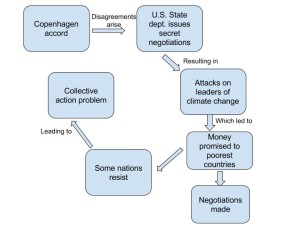My diagram depicts the main ideas behind WikiLeaks and its connection to climate change. There are several factors that link the leaked cables to climate change. Starting with the Copenhagen accord, disagreements arose amongst the nations in regards to how to handle climate change. The U.S. State department then issued secret negotiations, with some acting as attacks on leaders of climate change. For example, an attack was aimed at the US climate envoy, Todd Stern in regards to obtaining support from Beijing. The poorest countries affected by climate change who were not directly contributing to it were also promised money for their support. Here the question of ethics arises, for it was as if the US was bribing other countries. Some countries like the Maldives accepted such negotiations and expressed their eagerness to support the accord, while others resisted. This leads to a collective action problem, as discussed in Module 9. There are some nations who are willing to work towards helping the effects of climate change and those who are stuck in their ways and are not willing to transition to more sustainable ways of energy. Those who had money offered to them were more eager to accept the bribes from the United States, but as discussed this is not necessarily ethical. If everyone is not on the same page about climate change, it will be hard to adapt to it and even change our ways. Thus, it becomes a continuing cycle and our environment will continue to suffer.
The leaked WikiLeaks cables present many issues that are not necessarily ethical nor that I agree with. For one, it is somewhat embarrassing that a country as prevalent as the United States, would try to secretly send messages, let alone attack climate change leaders through emails and bribes. In some ways, it was beneficial for the public to see the State Department cables. If they were never leaked, the general public would still have no idea of what went on between political powers and the bribery and threats that were used to obtain support from other nations. It was anthropocentric for the State Department to reach out to those countries who did not necessarily support the Copenhagen accord, for it was only in their interests to keep things the same so money did not shift in a different direction. Instead of conducting climate change diplomacy in this fashion, other tactics need to be discussed and implemented. When every nation in the world is involved, it becomes difficult to overcome the collective action problem, as mentioned previously. As discussed in the module, mitigation could be used to reduce the amount of climate change by reducing the amount of greenhouse gasses emitted into the atmosphere. Few countries may know about such techniques or lack the knowledge to do so. Adapting to climate change and working to reduce our role in it is a complex cycle of ideas and actions that everyone needs to be on the same page about. With time and cooperation, we may eventually be able to think as one and reduce the rate of climate change.


Hi Emily, my name is Nick Gasparovich. We had similar layouts of our system diagrams. We both understood that the source of these cables was the Copenhagen Accord, and it should be the start of the diagram. I feel your views on how the United States dealt with this accord are spot on! I agree that leaking the cables was good for the public. As voters we should see the types of diplomatic dishonesty politicians can have if they are left unchecked. While I believe the US was right to push for climate change mitigation the way they did so was wrong.
Check out my blog at http://geog030.dutton.psu.edu/2016/04/04/module-9-nick-gasparovich/
Hi! My name is Julie. Here is link to my post: https://wp.me/p3RCAy-dvR. I really liked the way you did your systems diagram. I found it very easy to follow and easy to understand. I like how you incorporated the idea of a collective action problem. I was interested in your views about how you called it embarrassing for the United States. I also agree with you on this matter.